#1900s extant garment
Text
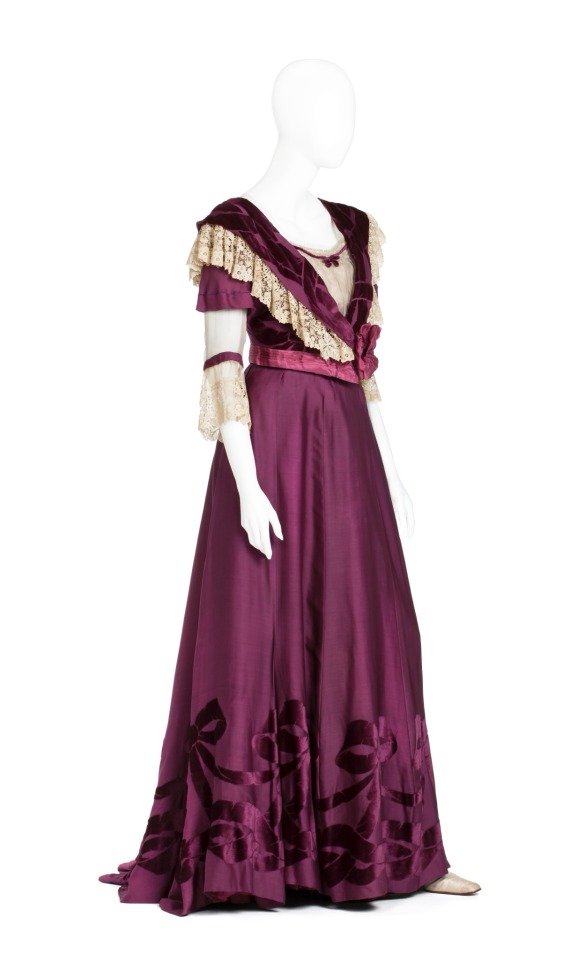
Purple silk dress, 1909, Swedish.
By Fr. V. Tunborg & Co.
Worn by Wilhelmina von Hallwyl at the wedding of her granddaughter.
Hallwylska museet.
#Fr. V. Tunborg & Co#Wilhelmina von Hallwyl#Hallwylska museet#womenswear#extant garments#dress#silk#20th century#1909#1900s#1900s dress#1900s Sweden#Sweden#1900s extant garment#lace
598 notes
·
View notes
Text
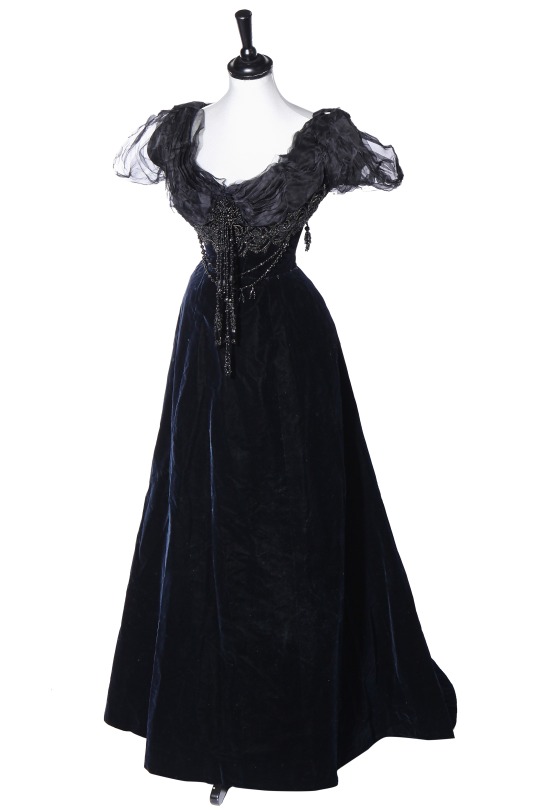


Evening dress ca. 1905
From Kerry Taylor Auctions
4K notes
·
View notes
Text
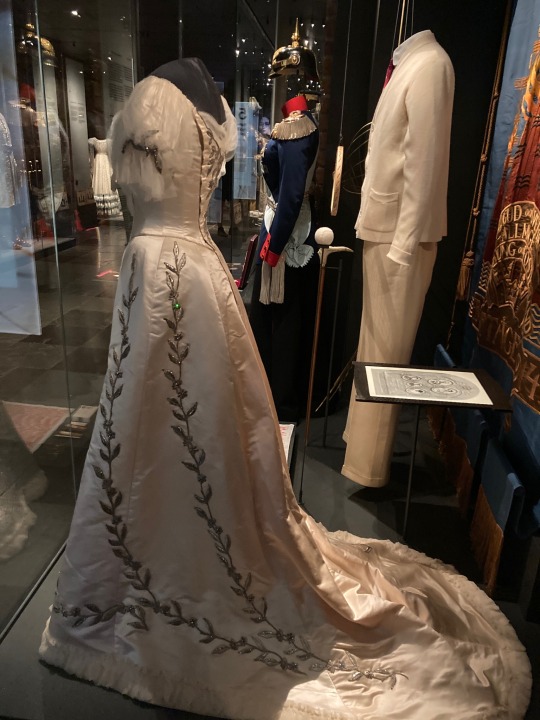






Crown Princess Victoria Of Sweden's Silver Wedding Gown
By Anna Grober
September 20, 1906
The Royal Armoury
Stockholm, Sweden
#Royal wedding gown#early 1900s fashion#antique gown#anna grober#extant garments#crown princess victoria#silver wedding gown#1906 fashion#royal armoury#stockholm#sweden
1 note
·
View note
Text
just saw someone say that it's easier for museums to keep smaller old clothes because smaller mannequins are easier to get than plus sized mannequins, and I, for one, as a museum worker, would LOVE to know where this person gets their small mannequins because we can't find ones tiny enough for our tiny old clothes. we have 2 (TWO!!) really small women's mannequins, with the smallest shoulders and smallest bust and tiniest of tiny waists and some of our oldest clothes still don't *quite* fit them right.
meanwhile with bigger clothes some of our modern mannequins are too small and we just stuff them with towels or paper or whatever. like it's fine, it's not super hard to scale mannequins *up*, there's tons of ways to do that (even if we don't have to do it all that often). but making them smaller? I've heard of museums who have sawed off boobs and shoulders to get mannequins to be small enough for old clothes because small enough mannequins are so hard to come by and modern mannequins are just too wide.
#historical fashion#museum talk#I'll be the first to admit survivor bias and museum bias are both things that exist#plus also people in the 18th/19th century were genuinely smaller than modern people#like less wide/less tall etc#because of awful nutrition and food shortages and rampant diseases and super bad air quality etc#and from roughly 1900-1950s-ish onward people have been getting taller/wider again#which is something that gets left out of the whole 'were people smaller or not' debate very often#everytime that debate pops up - which is VERY often - people seem to think it's only about waists#but actually the whole 'people were smaller' thing was not about plus size people not existing#it was about people being smaller on average in every single way back in the day#like I just saw that the average french man in this time was 162cm tall. that's tiny! and it's because nutrition sucked!#and that's also why so many extant garments are TINY. because the people were too#it's not a waist thing. it's an overall size thing.
1 note
·
View note
Text
☆Update 2:☆
I remembered to take pics today! Sort of. Only after i had put away my machines and stuff...
Here are (most) of my edwardian undergarments
(i am wearing modern clothes under bcs the internet is weird)
Chemise, bustle pad, underbust corset, petticoat
I still need to make a corset cover someday, ive just been using a second thin chemise over all this:
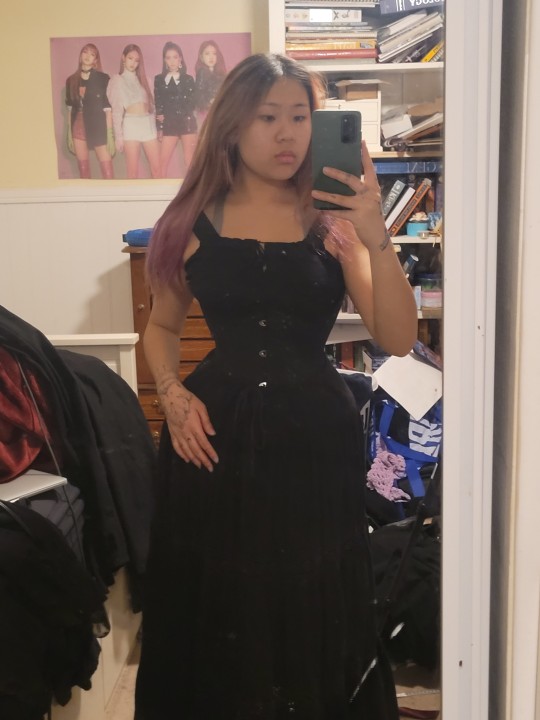
I used these vintage buttons on the cuffs. I wanted some more security but ran out of buttons so i used small snaps:
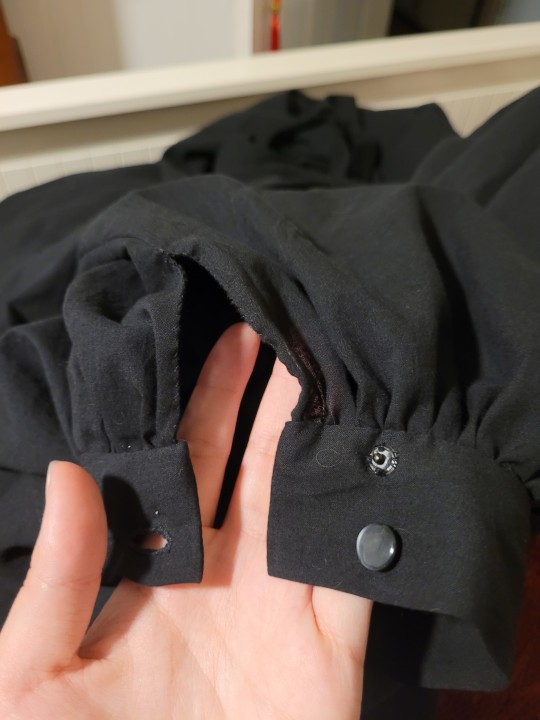
Also put one on the collar so i could try it on. I think the placket at the back of the blouse is a little ugly and larger than ive seen in extant garments but i forgot to adjust the pattern for my broad shoulders and need the extra width for comfort.

I tried on the blouse and skirt together:

I may need to loosen the waistband of the skirt, the corset is a bit bulkier than i thought itd be. Also the blouse is just stuffed into the skirt and currently only has one closure on at the collar so it looks a little bit disproportionate. The belt/sash will help smooth everything out so i dont look like im drowning in voile.
I might go without the bustle pad during the final shoot because i think it gives too much volume in the waist/hip area for edwardian tastes. Its from an 1890s pattern, so the silhouette is a bit out of date. I should probably try the skirt on without the pad before extending the waistband though.
Im pretty happy with how the sleeves turned out! I have some vintage nottingham lace i bought on etsy from penelope textiles that i was going to add to another project. I think ill sew some different laces together and add it to the cuffs to elongate them a bit. Since this dress is supposed to be from roughly 1905, i want the sleeves to look as they wouldve in that time. The photos ive seen mostly feature large ruffles at the ends of elbow-length sleeves but i dont think ill be likely to wear ruffles very often. Ive also seen tighter cuffs that extend from the elbow to mid-forearm or from the elbow to wrist. I think the elbow-length sleeves are a feature of afternoon dresses but i could be wrong. Maybe that was just day dresses? Not sure.
Im also not sure if i want to get gloves/a hat/parasol for this project. On one hand, it would look really cool for the video. On the other hand, it sounds quite expensive and i doubt ill wear it again. I dont want to buy things i wont use and create waste, theres enough of that in fashion. I have a pink 1900s parasol that i might cover with black fabric, but idk.
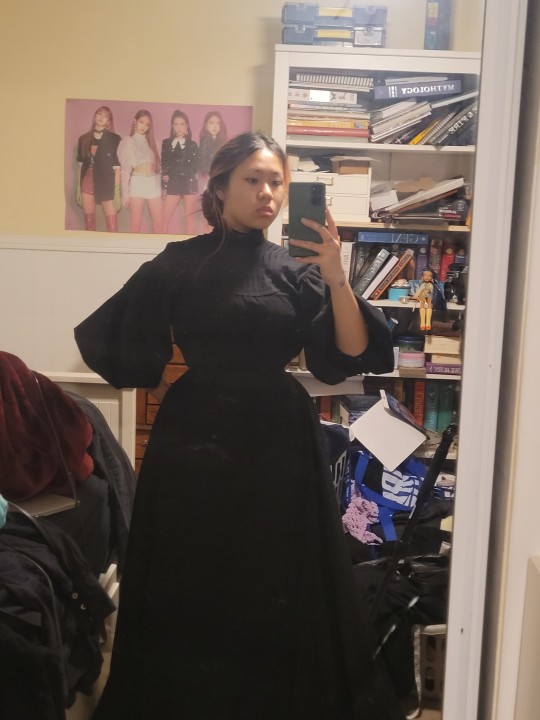
There isnt much left to do! Im gonna make a list here so i have it written somewhere:
-sew snaps onto blouse
-finish blouse hem
-attatch lace cuffs
-press pleats on sash/belt
-order synthetic whalebones
-add bones, hook/bars to belt
This is just the sewing tasks though, i need to edit the video clips and record audio. I have no idea how to do any of this. I just downloaded davinci video editor so hopefully i can figure it out. The only experience i have with video making/editing was in 3rd grade on ipads on the imovie app. Ive just been binge watching bernadette banner videos bcs i love her video style.
Any tips/feedback are much appreciated! ♡
Date: 4/22/24
#edwardian fashion#1900s#early 1900s#edwardian era#edwardian#victorian mourning#victorian dress#victorian era#victorian fashion#fashion history#historical costuming#historical dress#historical fashion
67 notes
·
View notes
Note
I'm new to the historical costuming and historybounding community and I noticed something odd and I wnated to know your opinion about it.
1850s/60s clothes are essentially nonexistent in the community at large. Every now and again, someone will make a Little Women inspired something, but that's it. No one seems to dislike this period, but no one seems to love it either?
Which confuses me so much because I would have assumed it to be one of the most popular styles, the way that the 1890s are in actuality.
Oh yeah, you're absolutely right! It IS rather underrepresented.
My main thought is that it's less practical for potential everyday modern wear than the later 19th century, and therefore less popular. Hoop skirts are marvelous, and not as huge or unwieldy as people like to think, but they're still not terribly practical for most people's lives nowadays. I adore the late 60s/early 70s elliptical skirt and bustle styles, but taking up so much space on the train would get me intense dirty looks at minimum. So I tend to aim a bit later- Natural Form or 1880s/90s transitional.
(Though I admit, it IS rather frustrating that almost every other daily wear historical costumer does 1890s/early 1900s. I want tips for styling a blouse so it looks less Edwardian Shirtwaist and more 1879 Blouse Waist, damnit! I can look at ads and photos and extant garments and fashion plates myself, but I'd love to have living people to compare notes with.)
I can recommend two bloggers who do more 1860s stuff, though: The Quintessential Clothes-Pen (Quinn Burgess) and Plaid Petticoats (Raven Stern). They do other eras as well, but it's not as much of an 1890s washout as popular costubers sometimes tend to be- with no hate intended to those people; that's just what they like to make! Neither of the bloggers I recommended are Everyday Victorian Clothing people, so that might contribute to their era flexibility.
Best of luck in finding your 1860s dream content!
(Also, if you DO want some more practical everyday 1860s, you could try looking at 1867-69; there was a brief A-line skirt moment there that everyone forgets about, but which would be less space-consuming than hoops.)
122 notes
·
View notes
Text
Andrew and Historical Sewing
halfway through his junior year Andrew discovers historical costuming and thinks oh this, this is amazing
he spends 2 weeks catching up on all the greats videos (iykyk)
his favorite era is late 1800s/early 1900s and his favorite costumer is of course the queen Bernadette Banner
after watching her lady sherlock series he decides he needs to hand sew a walking skirt like now
does he have absolutely any use for a walking skirt? no, but he'll worry about that later
5 yards of wool and notions and a delivery from Truly Victorian later, Neil comes home to him sprawled over the dorm floor, furniture pushed back to make room for his fabric
Neil of course knows what's happening, he's been watching along with Andrew but it's still hilarious as all hell
he spends 2 hours meticulously placing and pinning his pattern because it needs to match the grain line neil, you wouldn't understand
the first few stitches are a bit interesting, but he quickly gets the hang of it after watching so many costumers
if Neil sits next to him and just watches his hands as he hand fells seams with tiny stitches, that's his business and no one elses
a month or so later the skirt is done, if a bit wonky, but it's his first try and he's so proud (Neil watches his face light up as Renee models it for him and can't help the warm feeling in his chest)
he doesn't have much time to sew with practice and classes, but it quickly becomes his favorite thing to do at the end of a stressful or bad day
slowly he starts to incorporate things he's made into his wardrobe, just enough to be subtle while still being proud of what he's made
a pirate shirt here, wool trousers there, nothing to distinctive as he still likes his regular style
every year Andrew makes new suits for the banquets for him and Neil, mostly because he's improved so much and do you see that tailoring job Neil? absolutely horrid but also because that means he gets to take Neil's measurements again
when he graduates and starts making that sweet sweet exy money he starts his extant garment collection and finally gets his hands on a antique treadle machine
much like in college he doesn't have much time to sew but having a machine helps
he continues making projects for fun and for gifts, but after he retires he finally has the time to really do something with his skills
he starts up an instagram, where he posts short sewing videos and styled images of his garments
his work takes off pretty quick as he's already spent years developing his skill, something he mentions very often along with showing his first projects to encourage people to take up their own
thanks to his retirement fund he gets to keep doing it for fun, selling commissioned pieces occasionally
Neil is his model half the time and likes to show up in the background of his videos which is how the media catches wind of their relationship (not really though, it took Andrew answering a question about who tf the guy cradling two cats behind him is with a long sigh and my idiot husband for them to finally realize)
and if anyone asks his favorite Worth dress is the lily dress, but they also get a long rant cause gd he hates Worth the guy sucked
#me 🤝 projecting my niche interests onto my favorite character#it's fun what can i say#aftg#andrew minyard#andreil#neil josten#andrew x neil#the foxhole court#aftg hc#andreil hc#andreil headcanon#fox's writing#i've wanted to write this for so long and i finally have ; ;
87 notes
·
View notes
Text
History of Chinese standing collars (part 1: Ming & Qing)
So, a lot of people nowadays refer to a certain type of standing collar as a “Mandarin collar” but I'm not sure if that’s legit, because standing collars throughout Chinese history looked different. I was confronted by this topic when I was writing my post on 1950s Chinese fashion and felt like I had to make a separate post. I’m gonna do a quick break down of all the different types of standing collars in historical Chinese fashion from the 16th century to the present and how they developed.
Ming Dynasty (1368-1644)
The first mature 立领 liling standing collars were applied to women’s robes in the late 15th/early 16th century. Before any garment with a standing collar was invented, both men and women in Ming China wore garments with either a 圆领 yuanling round collar, 直领 zhiling parallel collar or 交领 jiaoling crossover collar, with crossover collars being the more common in womenswear.

Source here
Early Ming Dynasty portrait of a lady in a crossover collar robe.
The development of a standing collar was in large part thanks to the invention/adoption of the 子母扣 zimukou metal clasp button. I wonder why the fabric knotted buttons used on round collar robes were not used on standing collars in this period? They were awfully similar to the pankous of later. Anyway, at one point in the 15th century, some women thought it would be cool to add zimukou to their clothes and it resulted in this (they were also used on 比甲 bijia, 半臂 banbi and 短衫 duanshan but those are irrelevant to collars):
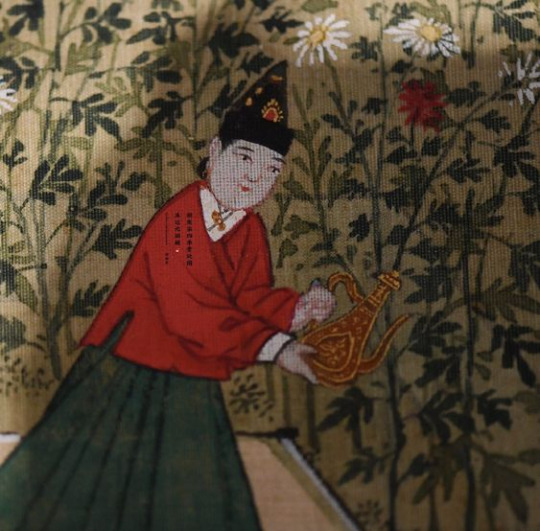
Source here
Part of 明宪宗元宵行乐图 (a painting depicting various Lantern Festival activities at the court of Emperor Xianzong), 1485. This lady is wearing a crossover collar robe with a zimukou at the middle.
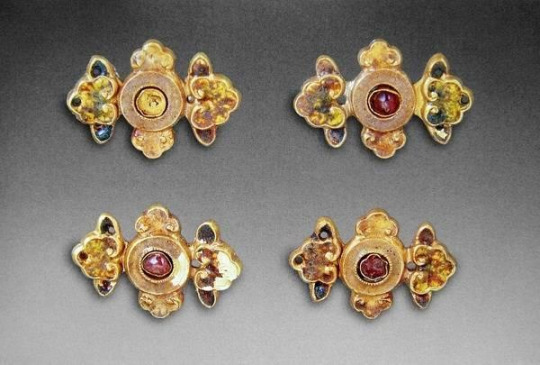
Source here
Modern reproduction zimukou. You could buy these for cheap on Taobao if you want to sew your own Ming style hanfu btw.
In the 16th century a fashion revolution took place in China: the standing collar, which came out of nowhere, began to suddenly dominate women’s clothing. This OG Chinese standing collar was very tall and form fitting, usually covering all of the wearer’s neck. It had sharp, rectangular edges and was closed by two zimukou, one placed at the bottom of the collar where it meets the bodice and another slightly above, not reaching the top of the collar. An important feature that set this apart from the collars of the 20th century is that it was unstiffened and made of the same fabric as the robe, meaning it was soft and could be worn with the top bit folded over, showing the lining which could be of a contrasting color. For archival purposes let’s call this collar style 1.
There are various theories as to why the standing collar was invented, e.g. because of colder climate during the little ice age, which peaked in the late 16th/early 17th century. Methinks it was just a fad which stayed.
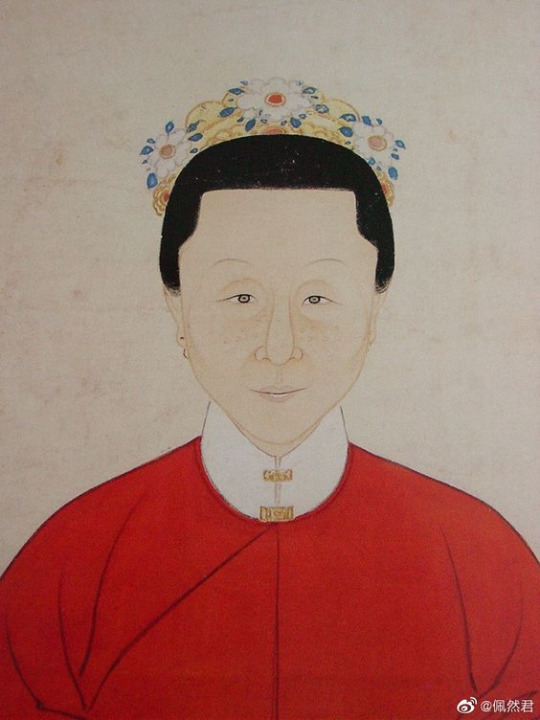
Source here
Late Ming Dynasty portrait, collar style 1.
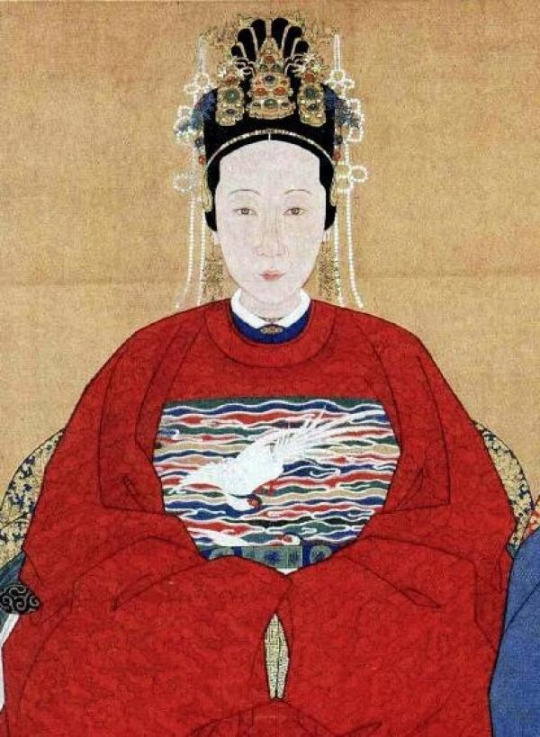
Source here
Late 16th century/early 17th century aristocratic lady wearing a standing collar robe underneath a round collar robe. The top of her collar is folded over. Collar style 1 variation 2.
Qing Dynasty (1644-1911)
This style of collar became the norm for Han Chinese women’s fashion in the mid to late 16th century and stayed that way throughout the 17th and 18th centuries. While the clothing silhouettes and accessories changed, the shape of the standing collar remained the same.
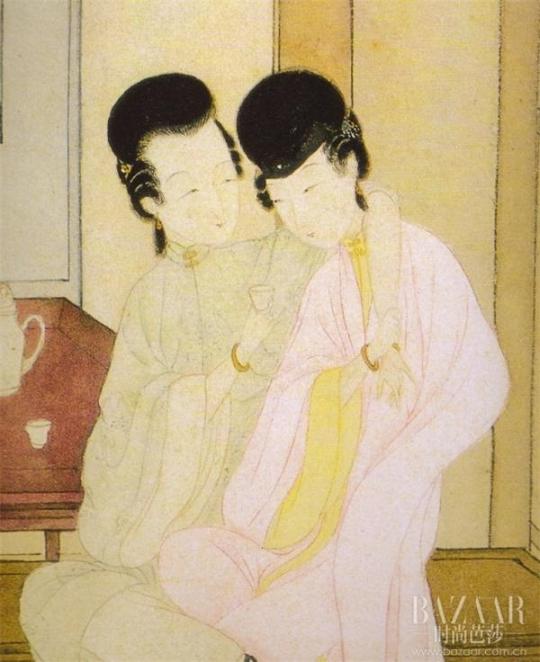
Source here
Late 17th century illustration for pornographic novel 肉蒲团 (1657). Collar style 1, but it became fashionable in the 17th century to have rows of piping around the neck for each button, so variation 3. Oh and wlw pride come throoouuuugh
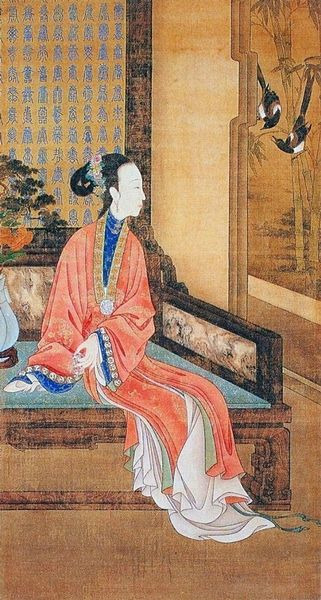
Source here
Early 18th century court painting, collar style 1 variation 3.
At some point in the late 18th century Han women decided it would be cool to use 盘扣 pankou, this fabric braided/knotted button of Manchu origin (more on Manchu dress later) on their collars instead of zimukou. The decoration also became more extravagant, with often rows of thick binding, piping or trim, corresponding to the decorations on the rest of the robe. It’s also slightly shorter, the upper button being at the very top of the collar. Let’s call this collar style 2.

Source here
(Presumably) late 18th century reverse glass painting showing collar style 2. The late 18th century deserves more attention, it’s such an important transitional period but also charming in its own way. This is true of European fashion of the period as well, I honestly love both places in the late 18th century.
In the beginning of the 19th century, the fashionable collar shape suddenly changed for some reason. It became extremely low, approximately only 1-2cm tall, only tall enough to accommodate one button. It still had crisp, rectangular edges. You could say this is another variation of collar style 2 but it is so iconic to the 19th century I think I’ll call this collar style 3.

Source here
Reverse glass painting ca. 1830. Han lady wearing a robe with collar style 3.
Now a brief look at Manchu womenswear. I am not an expert on Manchu historical fashion so tell me if I’m wrong. So the Manchus, who were apparently a confederation of Jurchen tribes from the area in what is northeastern China nowadays, invaded China successfully in the 1640s and remained the rulers of China until 1911 when they were replaced by the Republic of China. Throughout most of the Qing Dynasty Manchu women wore collarless robes, it was not until the mid 19th century that some Manchu women started to wear detachable collars to emulate Han women’s fashion, and not until around 1908 (!) when standing collars were actually added to their gowns themselves. Yes, period dramas did Manchu women dirty, poor gals have been dressed in the wrong costumes this, entire, time. The misrepresentation of Manchu historical fashion in the media in general is just fucking infuriating, but well, topic for a future post.

Source here
Late 17th century/early 18th century portrait of a Manchu lady. She is wearing a 衬衣 chenyi, a robe with straight sleeves, no slits and closed at the right side. It’s a casual gown worn for everyday activities. Her chenyi is collarless and the collar is closed by binding.
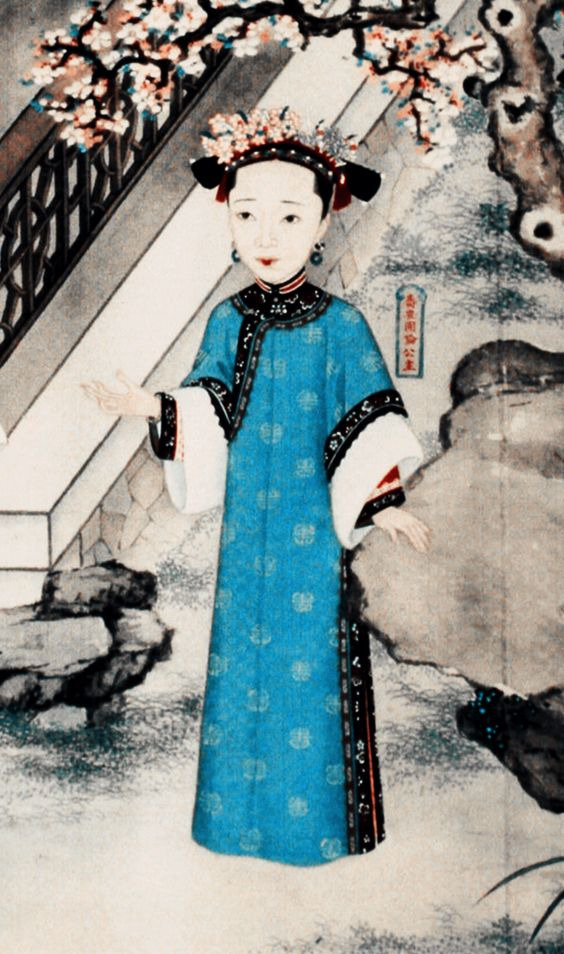
Source here
1840s/1850s court gown. She is wearing 氅衣 changyi (the bottom part of the first character should be 衣 not 毛 but this character is so obscure that it literally DOES NOT EXIST in the Chinese language anymore omg), a more elaborate style developed in the early 19th century with slits down both sides and wide trims along the collar, cuffs, side closure, side slits and hem. I have yet to see an extant example with a standing collar, all the changyi from the 19th century I’ve seen in museum collections are collarless, so the collar seen in paintings must’ve been detachable. Maybe some Manchu women liked Han women’s fashion and wanted to wear a detachable collar. I have, however, seen Manchu women’s vests and jackets with standing collars. These were similar to late 18th century Han women’s collars, so collar style 2.
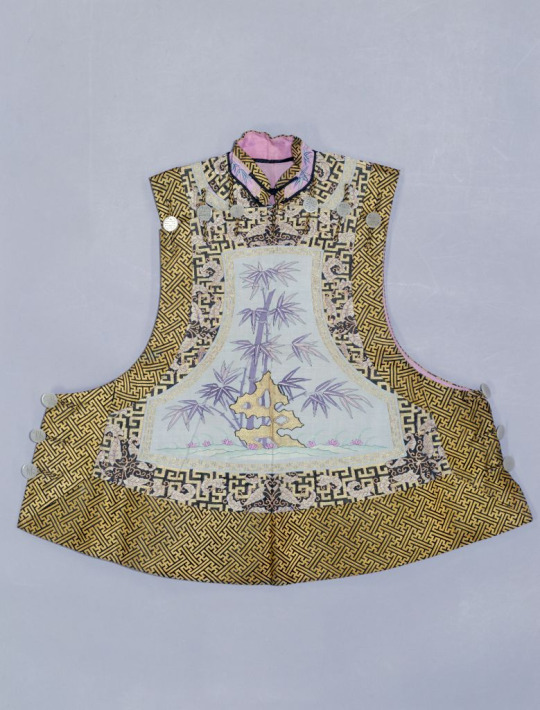
Source here
1890s/1900s women’s vest with collar style 2.
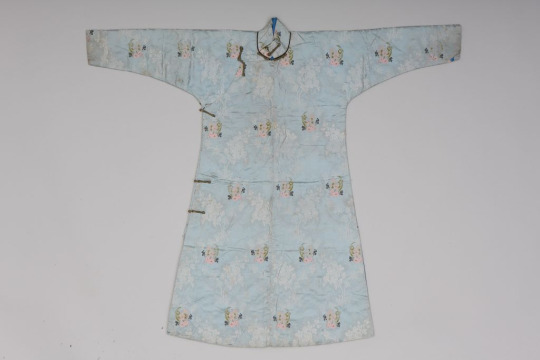
Source here
Ca. 1908. Chenyi with standing collar. If the passage of time is still not clear, notice the Western fabric used. Collar style 2.
At first glance this might look like a cheongsam but it is not. Chenyi did not have slits down the sides, unlike most 20th century cheongsam. It may have been a source of inspiration for cheongsam though, as I have explained in one of my 1930s posts, although the more obvious prototype for cheongsam was the changyi with slits and standing collars.
Let us now turn our attention to Manchu menswear, which is where things get complicated. In the 17th and 18th centuries, the Manchu riding habit, 行服袍 xingfupao, was a form fitting calf length robe with form fitting long sleeves and 马蹄袖 matixiu “horse hoof cuffs”, closed at the side with pankou. It was constructed in the same method as Han Chinese clothing. This original Manchu robe was collarless----I cannot stress this enough. The Manchus did not come barging into China wearing robes with standing collars goddamnit, get your facts right period dramas.

Source here
Portrait of Emperor Kangxi in a xingfupao. This is from the early 18th century already but the style didn’t change much so you get the idea. I love this color btw I think he looks great in it.
The xingfupao was an informal riding habit and only one small part in the gigantic system of Manchu court dress, the rules of which are well documented but I don’t bother to look them up. If you would like to do that, Google 大清会典. At one point in the early 18th century some Manchu dudes decided it was cool to add a collar to their xingfupao (like... Han women??) and it resulted in this:

Source here
An early example from the Kangxi era (1661-1722), a xingfupao with a standing collar of a contrasting color. The hem is detachable for horse riding (horse riding was an important aspect of Manchu culture and that influenced many of their fashion decisions). Judging by the fur lining I assume the standing collar was added for warmth in winter? I also saw some xingfupao with fur trim attached to standing collars so maybe that was the purpose.
Standing collars on xingfupao was constructed in a similar way to Han women’s collars, with rectangular edges and closed by two buttons. Pankous, which were unique to Manchu dress, were used instead of the Han zimukou. It appears that this collar was also soft and unstiffened, so it could be worn with the top bit folded over like in ye olde times (the 16th century). It’s important to note that xingfupao with a standing collar were not common at all, maybe a 1/20 probability to see in museum collections. Construction wise it’s similar to collar style 2 but it appeared earlier and was exclusive to menswear, so let’s call it collar style 4.

Source here
Qianlong era (1735-1796) portrait, xingfupao with standing collar of the same color folded over. Collar style 4 variation 2.
Another garment with a standing collar was the dress of the officials, known by white people as “Mandarins”. From the artworks and photographs I’ve seen, the collar only appeared in the outfit with a 行服褂 xingfugua, a button down tunic with straight, wide sleeves and slits at the front, back and sides. It was usually worn in combination with xingfupao, like how a shirt and vest are fixed combinations in European menswear. However, the collar of this kind of outfit was separate from the tunic itself. A plastron with an attached collar was worn underneath the robe and tunic (completely detachable collars were also used I think??) and the collar was buttoned from the inside. Not sure if this qualifies as a standing collar at all since it isn’t even attached to the robe itself, but anyway let’s just call this collar style 5.
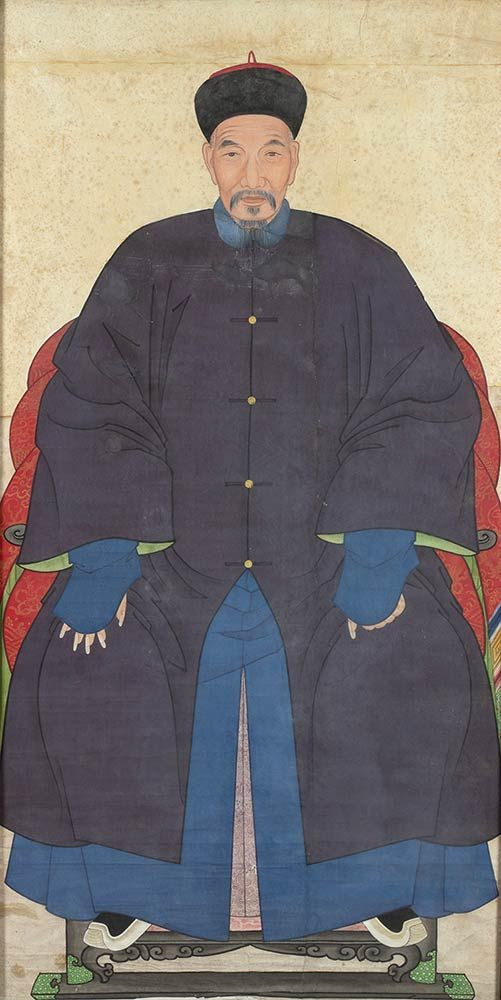
Source here
19th century portrait of an official. He is wearing a blue xingfupao, an indigo xingfugua and a blue detachable collar; a standard ensemble (well he’s also wearing pants and boots and stuff but that’s not the focus here). Collar style 5.
Oh I forgot to mention, after the Manchus took over China, they enforced their dress code on Han Chinese men but not Han Chinese women, so in the Qing Dynasty Han and Manchu menswear were one and the same but Han and Manchu womenswear were not.
I’ve only been talking about court dress so far, educated/well off civilian Han men would wear 长衫 changshan, a floor length robe, sometimes with a 马褂 magua, a short riding vest (derived from xingfugua), whereas poorer Han men would wear 短打 duanda, a short button down shirt, and pants. Well people who wore changshan also wore pants underneath but they’re not visible. All men wore pants tbh (incoming tangent), a while back when Harry Styles in a dress (which I stan) was making the rounds on social media some well meaning people were trying to find historical precedents for men wearing dresses and they named Chinese historical clothing as an example. I just wanna say, while I appreciate the sentiment, the harsh reality was that historical Han Chinese fashion was extremely gendered (except for a few brief time periods and a few select garments). Pants were reserved for men and skirts for women, the long gown like garments seen on men in historical portraiture were all robes, not dresses; you wouldn’t consider a long coat or bathrobe a dress nowadays, would you? Men always wore pants as undergarments while women wore petticoats. However I think that’s great for illustrating how our perception of whether a garment is masculine/feminine could change over time and that gender is socially constructed. Back to the main topic, to my knowledge, magua never had collars because it was a vest, changshan commonly had collars and duanda sometimes did too. I’m not sure when the standing collar began to appear on changshan, maybe when the court xingfupao gained collar style 4 it stuck in civilian fashion, maybe it was some point in the 19th century.
Anyway, fast forward to the late 19th century, the men’s changshan had a tall standing collar but again it was different to everything we’ve seen so far. It was exceptionally tall and had a smoothly tapering edge closed by only one pankou at the bottom. This resulted in a huge v shape gap down the middle. It’s still unstiffened but because of the lack of a rectangular edge it couldn’t be worn folded over. Let’s call this collar style 6.

Source here
Late 19th century/early 20th century portrait of a man. Changshan with collar style 6.
Let’s finish this part with Han women’s collars in the 1890s and 1900s. Around this time Han womenswear began to modernize and become simpler, but that trend did not apply to collars: the collars of Han women’s robes suddenly became unnaturally tall. They were so tall that they touched the wearer’s cheeks and couldn’t be closed at the front at all, kind of resembling Regency era European men’s collars?? This style of collar was oftentimes called 元宝领 yuanbaoling, ingot collar, or 马鞍领 ma’anling, saddle collar, after the object it resembles. Let’s call all of these tall collars that touch the wearer’s face collar style 7, but bear in mind these had a lot of variations.

Source here
Photograph from the 1900s. This could be categorized as a cursed variation of collar style 6 judging from how it only has one pankou and a tapering edge instead of a rectangular edge. But like, belle époque Chinese collars are a whole other species, so let’s comfortably call it collar style 7.

Source here
More collar style 7 representation. This collar style will never stop being funny to me, like just look at it it’s so tall.
So, in summary:
Collar style 1: OG Ming Dynasty standing collar, in fashion from the 16th to mid 18th century. Tall, unstiffened, rectangular edges. Closed with two zimukou. Could have piping (17th & early 18th century). Could be worn with top bit folded over (16th & early 17th century). Worn by Han women.
Collar style 2: developed from collar style 1, popularized in the late 18th century. Medium height, unstiffened, rectangular edges. Closed with two pankou/other fabric buttons. Commonly has binding, piping or trim. Worn by Han women in the late 18th century, partially adopted by Manchu women in the late 19th century.
Collar style 3: developed from collar style 2, exclusive to the 19th century. Extremely short, unstiffened, rectangular edges. Closed with one pankou. Commonly has binding, piping or trim. Worn by Han women.
Collar style 4: collar style 2 but simpler, appeared in the late 17th/early 18th century. Tall, unstiffened, rectangular edges. Closed with two pankou. Commonly plain. Worn by Manchu & Han men.
Collar style 5: detachable standing collar, a staple of official’s uniforms throughout the Qing Dynasty. Medium height, unstiffened, rectangular/rounded edges. Buttoned from the inside. Always plain. Worn by all officials (exclusively men in this era).
Collar style 6: civilian men’s collar characterized by v shape gap at the front, I don’t know when it first appeared, some point in the Qing Dynasty. Tall, unstiffened, rounded and dramatically tapering edges. Closed by one pankou. Worn by civilian Manchu & Han men.
Collar style 7: cursed belle époque (1890s & 1900s) women’s collars that touched the wearer’s face. Extremely tall, stiffened, both rounded and rectangular edges existed. Closed by one pankou at the bottom but sometimes had more pankou for ornamental purposes. Worn by Han women in this period.
Join me next time as we dive into the Republican era where things get extra complicated.
#hanfu#historic fashion#chinese fashion#chinese history#ming dynasty#qing dynasty#16th century#17th century#18th century#19th century
344 notes
·
View notes
Text
Historical Accuracy of Costumes in Period Films - Enola Holmes
Disclaimer: I will put no spoilers so you can still read if you haven't seen the movie yet! This post is just me assessing the costumes and their historical accuracy.
First of all, since the movie came out I had already heard a lot about it in just those two days that I was very curious to see if it lived up to the hype and it truly did! It's well-made with round characters and a gripping story line. But enough about the movie, let's get on to the costumes.
The movie is set in 1884, and at first I thought she was born in 84 (because of the intro) so I did like a third of the movie thinking the costumes were outdated until I looked at a closeup of a newspaper and realized that it is set in 84, so yay for me. But anyways, here are the facts.
Enola is 16 years old, therefore considered a child/young woman in society and would be wearing children's clothing but we'll get to that later
There aren't many examples of children's clothing from that time so I'll have to refer to the few fashion plates that I can find.

This blue dress from the beginning of the film has basically everything one would expect from the very end of the 19th century, but not necessarily the 1880s. The loose front is a very end-of-the-century, more so even Edwardian thing, and from the fashion plates and magazines I could find it seems that children's clothing was heavily inspired by adult fashion. It has a very low waistline and is overall very straight. Enola's dress looks more 1900 except for the fitted sleeves which are accurate for the period. And the collar looks completely out of place. But, of course there’s always a but, this is just taking mainstream fashion into account. The Aesthetic Dress movement took place in the 1880s and the dresses would have looked somewhat similar to this one, with a loosely fitted front but they also had puffier sleeves, so it’s like they took some details from different movements and also took some inspiration from the Edwardians and put them all together in a dress.
Another thing I would like to add, (hence the advert - I had to make collages to fit 10 pictures in this post) I am not sure as it doesn't fit her character at all but she looks corseted in those pictures (I added the first one specifically because I think you're able to see the outline of a corset? Faintly?). Depending on your age and status and your parents' plans for you (aka if they wanted you to get married at 16), teens of that age would either wear a corset or not. But taking Enola's upbringing into account and it was rather uncommon for a 16 year old to be wearing a corset, not unseen but uncommon, I'd say that if the costume department decided to put Millie in a corset in that particular scene is historically inaccurate. There were corsets for young women/teens, but they didn't give you that extreme hourglass shape, they were straighter and didn't give you a tiny waist, like the bottom right one in this corset advert. Unfortunately, I could not find out when it's from but it should be somewhat close to the 1880s.
Next up, I would like to say that the length of the skirt they chose for Millie to wear is appropriate for a 16 year old! Unlike what we saw on Anne with an E...

At one point we get a look at her undergarments and they're looking fine for the time! The chemise and the drawers, she's obviously not wearing any petticoats as she's being measured but we saw a glimpse of a petticoat when she was riding a bike in an earlier scene so yes, this part is accurate.

Next up, I'd like to talk about this lady and her dress is just amazing, fashion plate worthy and absolutely accurate, I have nothing bad to say about this.

What I noticed overall in the movie was that the bustles weren't as extreme as I would have expected them to be, but it all had to do with personal preference so it's not necessarily historically inaccurate to see more lowkey bustles. But I didn't see one bustle that was just crazy in today's eyes so maybe they could have improved on that but I'm just nitpicking at this point. Or maybe I've just gotten so used to seeing old clothes that nothing shocks me anymore.
Here we can see some crinolines being sold and judging from their width they are somewhat outdated.

They could pass as maybe early 1870s if not even 1860s.
Now Enola wants to become a lady, so she has to wear adult clothes! Here, she goes into a shop and puts on her clothing. We can see here how poorly fitted the corset is; the lacing gap should be parallel but you can see in the mirror how it gets smaller towards the bottom. Maybe it was done unintentionally but maybe it's just supposed to show that ready-to-wear corsets just weren't made for the person buying them. But in that same scene, we finally get a proper bustle! That's historical accuracy right there!

Next up is her iconic red gown.

Now... I had a little bit of trouble with that one. The skirt is a little wide in my eyes, but the overall shape and cut is fine, with that layer draping over her underskirt. However, her neckline is something you wouldn't typically see. You see other characters wear high necklines, so I don't know why they chose to give this dress almost an evening wear look. V-necks did exist in evening wear, but then again they would be paired with frilly short sleeves and not tight fitting day wear sleeves. So all in all, yes, the dress is accurate but the neckline is uncommon.
Next, we have what is probably the most accurate one of her costumes – the mourning gown.
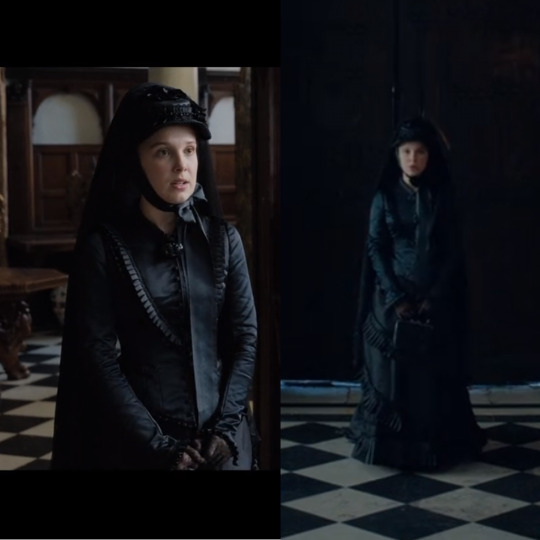
It's slimmer than the red one and there are so many examples of extant garments on google pictures that look so similar to hers that I'm just gonna say, excellent job!
Next is my favorite despite the neckline problem. She just looks so pretty in it!

The neckline isn't as low as on the red one but still quite uncommon. Another detail you can see in the second picture is that she seems to be wearing a bum pad instead of a bustle, which I think is acceptable. It's slim, it has a layer that drapes over the underskirt in the front, and even the sleeves are a little bit gathered at the top which was very common.
And lastly, we have this white dress where she goes back to the style she wore at the beginning of the movie.
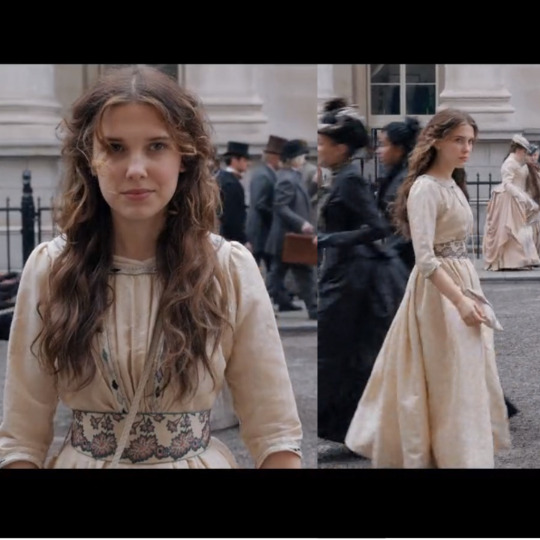
And once again, just like I said in the beginning, this is not something you’d really see being worn in that time unless we’re talking about the Aesthetic Dress and now the sleeves aren’t as fitted so it makes sense for the movement, plus it’s kept very simple.
Overall you can say they did a fairly good job at making everything historically accurate but took some artistic liberties here and there, just like you would expect from a movie.
#enola holmes#sherlock holmes#millie bobby brown#victorian fashion#fashion history#historical fashion#period movies#enola#1880#19th century#1880s fashion#corset#fashion#victorian
1K notes
·
View notes
Photo

Evening dress (via The Met)
Evening dress
Design House:House of Worth (French, 1858–1956)
Date:1898–1900
Culture:French
Medium:silk
Credit Line:Gift of Miss Eva Drexel Dahlgren, 1976
Accession Number:1976.258.1a, b
#House of Worth#silk gown#all the dresses of this silhouette i like turn out to be worth dresse#last gala gown inspiration#currently in the metropolitan museum#extant garments#1900s dress
3 notes
·
View notes
Text
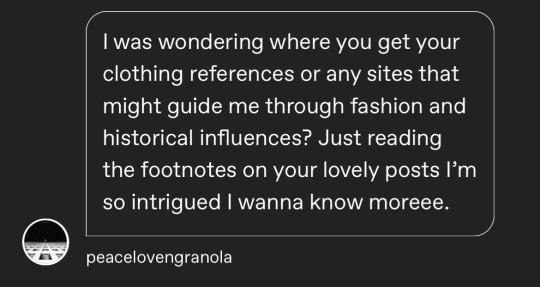
@peacelovengranola had a really great question over on my Lord Stark piece that I wanted to answer as a post, since this might get lengthy.
Full disclosure: I am not a historian or anything related to that, I'm just a hobbyist costume geek who loves clothing and history. Please don't consider this The Definitive Guide To anything, just suggestions of what works for me and where to get started when digging in to (specifically Western European & North American) fashion.
For all of my Semi-Historical Stark pieces, my primary sources are artwork from the period (and in some case photos and extant fashion pieces), as well as books. Loooots of books. Once I hit the later 19th century, things like fashion ads, department store catalogs, magazines, and pattern books are incredibly useful tools for fashion history references.
(I recommend avoiding fantasy art depicting mythological folks {gods, the Saints, King Arthur etc} because the fashions get a little, well, fantastical, heads up)
Because there's just so much knowledge out there, and it's intimidating as heck, I go for broad strokes first ("What era do I want to learn about?") then I start carving out specifics.
"Specifics"?
Lord Stark's overall look is from the Renaissance, sure, but specifically England in the 1560s. He's also meant to be a nobleman, as class distinction (and career) is important to how he'd dress, the materials he'd wear, decorative motifs etc etc. While it seems like a lot to keep in mind, think of it as adding filters to a Google search, to help you narrow your focus (and save your sanity).
"But Beck, how do I know a site is legit with their info?"
Look for sources! Any article should list the sources or books they're referencing. Want to avoid Amazon? Thrift used copies or shop directly from the publisher. Can't find physical copies of them, or the copies that do exist are just obscenely expensive? Take advantage of sites like LibGen, Archive.org, and Hathitrust to read digital copies! Or search for Epubs and PDFs, friend!
(Though I would never, ever suggest you illegally download a book that's stupidly overpriced on Amazon or eBay 😶 That would be so wrong and mean to the seller 😶 {please DO support small businesses!})
(Also hilariously, Karolina Żebrowska answered a similar question last year so go watch/read her suggestions too, she actually knows way more than I do.)
Stuff I've been reading:
The Costume Institute at The Met
Fashion History Timeline
A Dictionary of Costume and Fashion - a definite (and cheap, yo!) must if you just want to know wtf something is called, which makes searching for specific examples a breeze.
Reference Book of Women's Vintage Clothing: 1900-1909
The Mode in Costume
Medieval Costume in England and France: The 13th, 14th, and 15th Centuries
European Civil & Military Clothing
Fashion in the Middle Ages
Vintage patterns you can read and reference. These are outstanding if you want to see what regular folks were making for themselves.
Example of a Sears Roebuck catalog from the 20's
Pinterest is a pretty good resource in a pinch, as you can often find fashion albums filtered to specific dates in history. Be aware that they might not always be accurate (unless they're dated on the photo, like with some fashion plates), so you may want to cross-reference as well.
--
This is just a super small sampling of what's out there to read! Don't be afraid to indulge in what you want to learn about either. If you just want to learn about Victorian bustle trends, or Black American hairstyles of the mid-1960s, or the garments of 12th century French peasants, go for it.
If you want to go into even further detail (and if you're a fellow artist), look up how period garments were worn, and the various underthings people wore as well. Get real extra with it and read up on where/how they lived, and their daily lives.
The sky's the limit here, have fun with it 👍 I hope this layperson's primer helps, and makes it a little less daunting.
39 notes
·
View notes
Photo
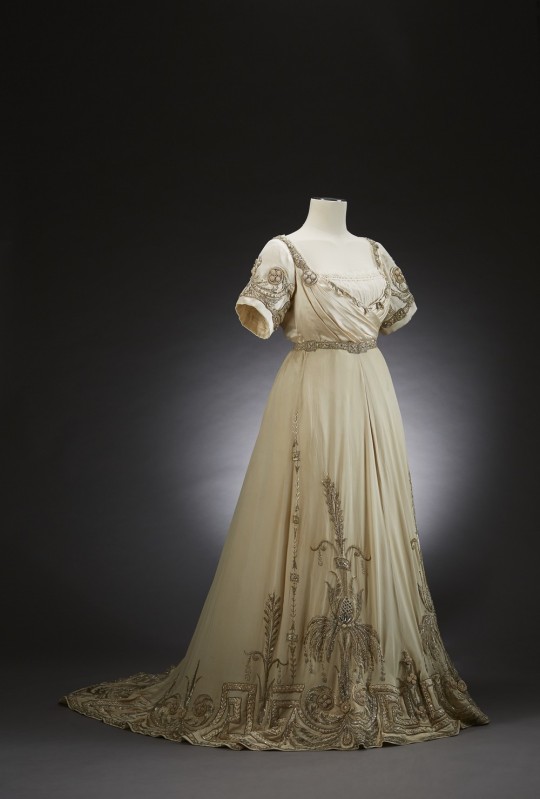
Wedding dress, 1907
From the Musée Mode & Dentelle
2K notes
·
View notes
Text
"...but both impulse and tango picking up knitting/crocheting (whichever is more historically accurate), despite it being unexpected of a boy to pick up, just to make handmade things for zed!!"
So let's talk knitting and crochet!! @thezitteam has a royalty au and I have stuff to say about the history of knitting and crochet after some brief research as well as with some prior knowledge, and I think it'll just be easier for me to be able to save drafts just in case since I may lose it if I forget and close the app while typing
-----
So! Knitting and crochet actually date back father than you may expect, with seemingly handmade garments resembling current works of knit or crocheted pieces! Actual evidence, as in a proper written form of the word crochet, goes back perhaps as far as the 18th or 19th century, and knitting even farther back to as early as, potentially, the 11th century.
And to further add on, these seem to have been viewed different than they are today, which is natural in history. While potentially a more popular activity among women, men also participated in these crafts since the need for textiles and protection against the elements was still pretty strong. So, technically, anyone could do it! In fact, in the Scottish Isles in the 17th and 18th centuries, it involved entire families at times.
But this is all to say, knitting and crochet have both been around for a while, and predecessors to both have been around even before documentation (such as nålebinding, which has a garment found to be from around 6500 BC, with another circa 4200 BC). In terms of historical accuracy, it really depends on the rough year the AU is set in or based around.
If it's based around the 1200's to 1900's, knitting has been recorded as work done by hired people in the late-ish 1100's to 1200's, a potential Shepard's activity around 1400's (however probably still commonplace among refined society), and probably a sort of house wive's activity throughout the 1700's to late 1800's, and begins dying down as you go through the late 1900's. And, during the 1800's to 1900's, crochet can be thrown into there as a possibility with wooden or bamboo hooks, and probably even earlier, but those are the times it seems a lot of extant garments were dated back to in terms of crochet.
Of course, there are also other crafts, such as sewing, which was also quite commonplace and hand stitched (asides from the use of handcranked sewing machines around the early 1900's, which can be used as an alternative to stitching by hand), and can likely be done by anyone even if it was still mostly done by women from the construction to the mending and tailoring. However, it is a possibility in about the 1800's to 1900's that men would also fashion their own clothing, though would probably still leave the mending to the women of the household, if I am remembering correctly.
But, I'd say, if Zera had sheep or a trade with another kingdom to get things like wool or yarn, or even their own sheep pen and some sort of spin wheel to make wool usable, then either one seems like a pretty good bet since they would have those resources!
#I quite love doing research it's really fun#but only for things like this because I like researching interesting things and I usually have an interest when it comes to stories#Sorry if this isn't exactly interesting by the way- I'm just now realizing it may be a tad uncalled for#oh well- it was fun no matter what!
6 notes
·
View notes
Text
I have fallen down a rabbit hole of fashion plates. Let's just - let's just have my Top Five fashion periods, yes?
#5. the 1850s
The era in which full skirts became a Thing and then crinolines were invented. A+++ social distancing. Also crazy curls and BONNETS? A++ would reccomend.
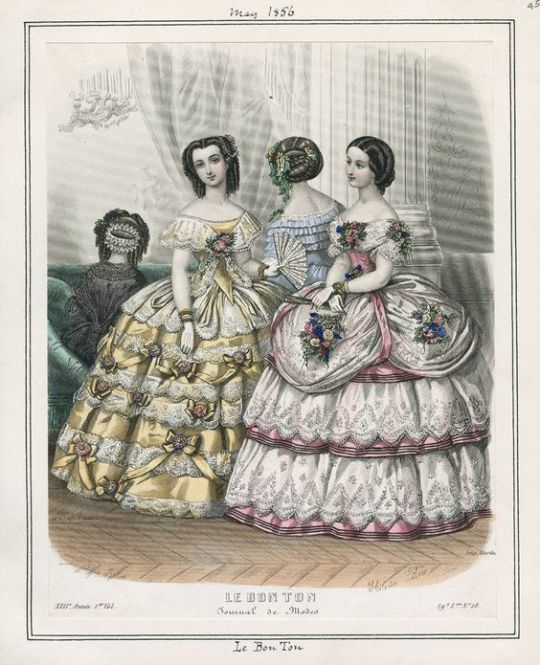
Fashion plate from Le Bon Ton: Journal de Modes, 1856.
#4. the 1900-1910s lingerie dress/gowns
People got a little extra with the lace in this period not gonna lie. It's glorious. These dresses were usually made of cotton batiste or cotton lawn, or other lightweight, sheer, and breathable fabric. Oh and don't forget obscene amounts of lace. Like. I could never afford that much lace on one single dress ohmygod.

Cotton batiste lingerie gown, 1900-1910, via Augusta Auctions.

Photo of a girl in a lingerie dress, 1900-1910, probably Russian.
#3. the 1870s aka the First Bustle Era
No need to ask your mother if your bum looks big in this. She'll probably say that it's not big enough anyway. The amount of Extra™ is really Just Right. Just - look at them.

Fashion plate from Le Moniteur de la Mode, 1872.

Fashion plate from Revue de la Mode, 1873.
#2. the 1820s
I'm pretty sure I've established that I am Extra™. Usually people just lump this decade into the Regency but no??? George was already king and the silhouettes aren't even that similar. The waistline in the 20s were gradually shifting downwards, in contrast to the extremely Extra™ (but not to my taste) shelf bust of the height of the Regency. People got a little crazy with the trim because the Napoleonic Wars were over and people had more spare money to spend on Extra™ things. Do not get me started on the Rouleaux trims.

Ball dress by John Bell, 1821, via Los Angeles County Museum of Art.

Fashion plate from La Belle Assemblée 1842, by John Bell.
#1. the 1830s aka the Romantic Era
Surprise surprise. If you thought that the 20s were Extra™ please consider this:

Fashion plate from Ladies' Pocket Magazine, 1832, via Los Angeles County Museum of Art.
The hair was Extra™, the bonnets were Extra™, the silhouettes were Extra™, the trimming was Extra. This is one of those fashion plates where I see it and go "That looks so crazy I must make one". And they're not hard to make. Giant rectangles for the skirt, half-circles for the sleeves and the most complicated part is the relatively simple bodice. And I get to jazz it up with lace and sparkly things. It's all the best parts of historical dressmaking in one.
Here, have another:
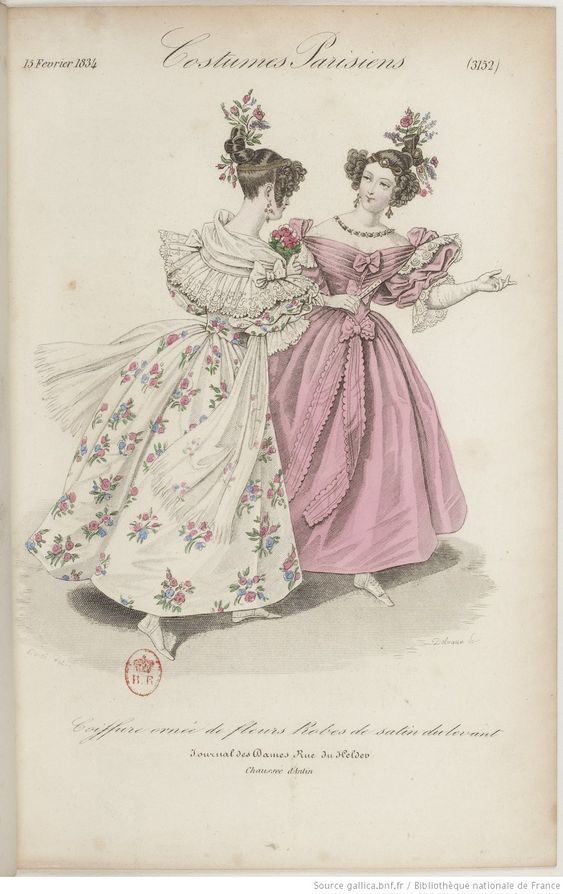
Fashion plate from Costumes Parisiens: Journal des Dames et des Modes, 1834.
And as a bonus for bearing with me until now, have a Cancelled™:
Regency court dresses.

And this is one of the relatively okay ones.
Yes, the court dresses in Bridgerton were very pretty, and yes, they were probably the most historically accurate out of their many, many costumes, but they were, unfortunately, French. The British ones looked like that. And this. And this. And all this. The literal lovechild of a Regency empire waist dress and a panier because the queen thought that the fashionable silhouette was too informal for court. Let's just say Queen Charlotte had approximately zero (0) taste.
Find more 1820s fashion plates and extant garments here, and Victorian ones here. Lady Rebecca Fashions on YouTube has a wonderful video on Regency court dresses here, and Pinsent Tailoring has a little bit of a meltdown over the men's costumes and talks about those godawful court dresses in this video.
#dress history#fashion history#daisy talks history#history#historical fashion#1850s fashion#1900s fashion#1870s fashion#1820s fashion#1830s fashion#regency court dresses#victorian fashion#regency fashion#bridgerton#long post
9 notes
·
View notes
Text
Our Collective 18th Century Library
This is a selection of books about the 18th century fashion, history, beauty, and life. Most of them in my personal library or have consulted but have not bought (yet). This post is going to be edited with more books added and reblogged for all to see, that’s why I called this post “our collective 18th century library”, from me to you all and then for you all to all of us.
Please add other books you have in your collections or you’ve read! And if you could keep the format (cover photo, book info, a little comment, the themes we can find in the book, and the link of where to find them), it will be consistently useful for everyone!
Let’s start:
ART

Casta Painting: Images of Race in Eighteenth-Century Mexico, by Ilona Katzew, Yale University Press, 2005, ISBN-10: 0300109717
Casta painting is a whole genre created in Mexico for depicting the population of the New Spain, and it’s whole purpose was to show the Spanish King what an organised viceroyalty it was, and how everyone has their proper place, even if that was not entirely true.
Themes: fashion (for visual reference), castas, race, Mexico, New Spain, Viceroyalty, the Americas, Mexico City, art, 18th century.
Available at: Amazon / Barnes and Noble / Waterstones

Painted in Mexico, 1700-1790: Pinxit Mexici, edited by Ilona Katzew, Prestel Publishing, 2017, ISBN: 978-3-7913-5677-8
The book from the exhibition about art made in Mexico City during the 18th century.
Themes: art, portraits, casta painting, Mexico, Mexico City, Viceroyalty, New Spain, the Americas, castas, religion, catholicism, 18th century.
Available at: Amazon / Amazon (Spanish version) / Target / Waterstones
HISTORY
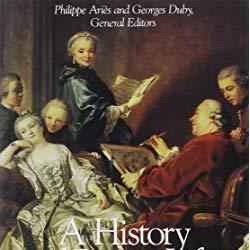
A History of Private Life, Volume III: Passions of the Renaissance, Edited by Roger Chartier, Series edited by Phillippe Ariès, Harvard University Press, 1993, ISBN 9780674400023
The life or ordinary people from the Renaissance to the Enlightenment, centered in Europe and especially France, you’ll read about the everyday lives of women and children, common men, education, marriage and well, the private life. This whole series (of 5 volumes) is worth each penny.
Themes: everyday life, history, women, Europe, France, children, education, Renaissance, Enlightenment, 16th century, 17th century, 18th century.
Available at: Amazon / Harvard University Press

A History of Private Life, Volume IV: From the Fires of Revolution to the Great War, Edited by Michelle Perrot, Series edited by Phillippe Ariès, Harvard University Press, 1993, ISBN 9780674400030
The first part is 18th century and deals with life pre, during and after French Revolution.
Themes: everyday life, history, women, Europe, France, children, education, Enlightenment, French Revolution, Victorian, Belle Epoque, WWI, 18th century, 19th century, 20th century.
Available at: Amazon / Harvard University Press

Black London: Life Before Emancipation, by Gretchen Gerzina, Rutgers University Press, 1995, ISBN-10: 0813522722
A glimpse into the lives of the thousands of Africans living in eighteenth century London.
Themes: everyday life, history, race, black, African, England, London, slavery, 18th century.
Available at: Amazon / You can also download it for FREE (ha! who needs Amazon now?)

Historia De La Vida Cotidiana En México 3: El siglo XVIII: entre la tradición y el cambio, by Pilar Gonzalbo Aizpuru, Fondo de Cultura Económica, 2012. ISBN-10: 9681677188
Common life in Mexico during the 18th century, from fashion, food and the markets, to the everyday life of mining cities, children and monks. This is book is a key reference for starting to read about the life of common people in the New Spain. Part of a series from the prehispanic times to the 20th century.
Themes: fashion, food, everyday life, New Spain, Mexico, Viceroyalty, The Americas, castas, mining, religion, catholicism, education, childhood, 18th century.
Available at: Amazon / Cambridge University Press / Fondo de Cultura Económica
FASHION

Auguste Racinet. The Costume History (Bibliotheca Universalis), Françoise Tétart-Vittu, Taschen, 2019, ISBN-10: 3836555409
I wanted to describe my undying love for this book, but I’m just gonna copy Taschen’s description: “Racinet’s Costume History is a landmark in the study of clothing and fashion. This reprint presents Racinet’s exquisitely precise color illustrations, as well as his delightful descriptions and witty commentary. From Eskimo attire to high French couture, this is an unrivalled encyclopedia for students, designers, artists, illustrators, and historians, and anyone interested in style.” So, yeah, this 19th century book rules.
Themes: fashion, interior design, furniture, 18th century, 19th century, fashion history, ancient times, middle ages, renaissance, baroque, rococo, victorian, menswear, womenswear.
Available at: Amazon / Taschen

Costume in Detail: 1730-1930, Nancy Bradfield, Quite Specific Media Group Ltd, 1999, ISBN-10: 0896762173
Focused on womenswear, Nancy Bradfield shares with all of us detailed illustrations and descriptions, as well as good information about fashion, garments, shapes, finishings, etc, of extant garments in private collections. A wonderful reference book for reproducing fashion and for illustrations or authors who want to give their character accurate fashion.
Themes: fashion,womenswear, extant garments, 18th century, 19th century, 20th century.
Available at: Amazon / Book Depository
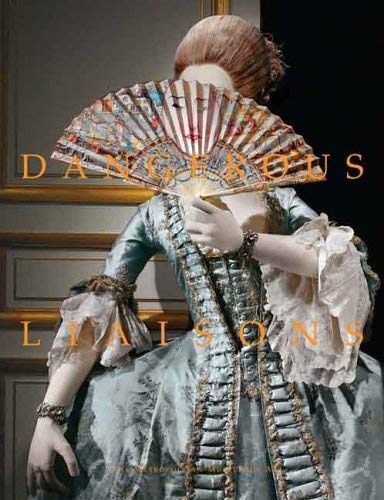
Dangerous Liaisons: Fashion and Furniture in the Eighteenth Century, by Harold Koda, Andrew Bolton, Mimi Hellman, Metropolitan Museum of Art 2006, ISBN-10: 0300107145
The book from a long gone exhibition at the Met Museum, it has extant clothes, good info, and the links between fashion and furniture design that make us perceive both as purely 18th century.
Themes: fashion, interior design, furniture, museum collections, extant garments, exhibition, 18th century.
Available at: Amazon / Metropolitan Museum of Art
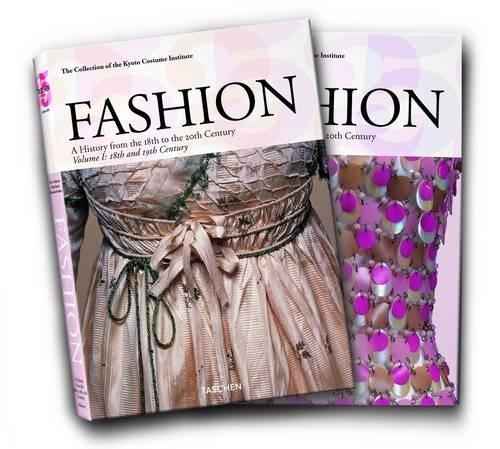
Fashion, A history from the 18th to the 20th century, by Akiko Fukai, Taschen 25th anniversary edition, 2007.
A basic fashion history book starting in the 18th century from the amazing collection of the Kyoto Costume Institute.
Themes: fashion, womenswear, menswear, embroidery, accessories, museum collection, extant garments, England, France, Europe, undergarments, 18th century, 19th century, 20th century.
Available at: Amazon in 1 volume and 2 volumes set.

Gallery of Late-Seventeenth-Century Costume: 100 Engravings, Caspar Luyken, Dover Publications, 2003, ISBN-10: 0486429865
Reprint of a collection of plates by Dutch engraver Caspar Luyken published in 1694. It shows men and women of different social classes and occupations. A key reference when looking for 17th century contemporary source material.
Themes: fashion, menswear, womenswear, Dutch, engraving, plates, 17th century, baroque, late 17th century, contemporary source.
Available at: Amazon / Dover Books

Historic Costumes and How to Make Them (Dover Fashion and Costumes), by Mary Fernald and Eileen Shenton, Dover Publications, 2006, ISBN-10: 0486449068
From the Middle Ages to the 19th century fashion, this book is a nice resource for theatrical costuming and has good but basic bits of historical fashion information. I recommend not to buy with no previous patternmaking and fashion background, since the diagrams are quite vague, and the descriptions even more. I personally only have used this book for reference of Medieval and early Renaissance fashion (which to be fair, are quite simple). Also, it is centered in English fashions.
Themes: fashion, theatre, menswear, womenswear, middle ages, renaissance, tudors, elizabethan, georgian, victorian, 15th century, 16th century, 17th century, 18th century, 19th century.
Available at: Amazon / Barnes and Noble / Dover Publications / Waterstones

How to Read a Dress, A Guide to Changing Fashion from the 16th to the 20th Century, Lydia Edwards, Bloomsbury Academic, 2017, ISBN-10: 1472533275
This books is very pretty and rather basic, it could be a really nice starting point for anyone getting an interest in fashion history. I’ve read reviews that it is “insultingly basic” which I do not get, I mean, if you cannot explain something in such a basic way that a child can get it, then you do not really master that subject. This books has pretty interesting info and it is a walkthrough of key silhouettes and extant garments, so it is not deeply detailed nor shows each and every silhouette of every decade of every century.
Themes: fashion, womenswear, gown, dresses, extant garments, museums, Europe, 16th century, 17th century, 18th century, 19th century, 20th century.
Available at: Amazon / Bloomsbury

Men's Garments 1830-1900: A Guide to Pattern Cutting and Tailoring, R. I. Davis and William-Alan Landes, Players Press, 1996, ISBN-10: 0887346480
A whole book only for menswear starting with the Regency silhouette and its very particular form until the turn of the 20th century. Yes. It is pretty good, I have to say, for all our Victorian outfit needs for the gentleman. I recommend this book (and the 2nd one on 19th and 20th centuries) for people with some knowledge of construction, grading, fitting, patternmaking, and tailoring, since it does not offer much sewing advice.
Themes: fashion, menswear, accessories, patternmaking, plates, 19th century, 20th century.
Available at: Amazon / Waterstones
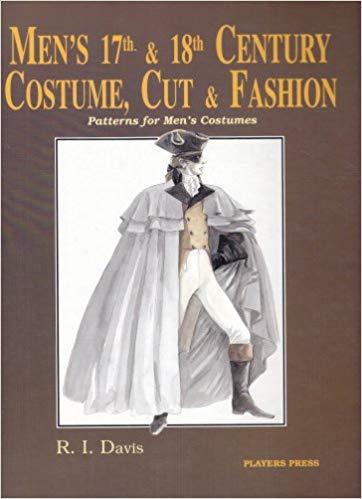
Men's Seventeenth & Eighteenth Century Costume: Cut and Fashion, R. I. Davis and William-Alan Landes, Players Press, 2000, ISBN-10: 0887346375
My personal love for menswear is fueled by this book that details the suits, coats and tailcoats from the 17th and 18th centuries. It includes military fashion and other everyday clothes like breeches, capes, waistcoats, etc. via plates, figures, diagrams and texts. I recommend this book (and the 1st one on 19th and 20th centuries) for people with some knowledge of construction, grading, fitting, patternmaking, and tailoring, since it does not offer much sewing advice.
Themes: fashion, menswear, accessories, patternmaking, plates, 17th century, 18th century.
Available at: Amazon / Book Depository
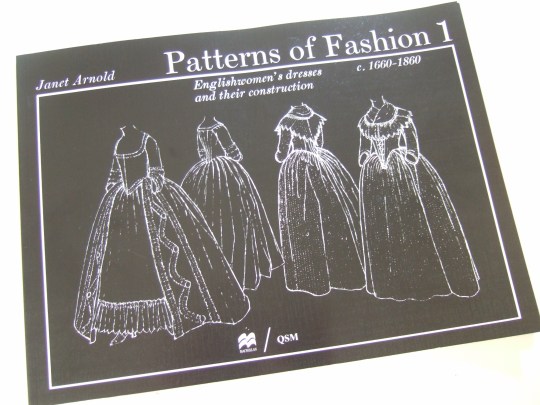
Patterns of Fashion 1: Englishwomen's Dresses and Their Construction C. 1660-1860, by Janet Arnold, Drama Publishers, 2005, ISBN-10: 9780896760264
THE key source of patterns of extant garments, this series of books are the result of constant research on garments from museums, with details and info on construction, history and fashion details. You know, the kind of information you could only get with those garments in your hands.
So, as a resume, in this list there’s only the books with 18th century info in them, BUT you should actually have ALL of the Patterns of Fashion books.
Themes: fashion, womenswear, England, extant garments, museums, Europe, patternmaking, 17th century, 18th century, 19th century.
Available at: Amazon
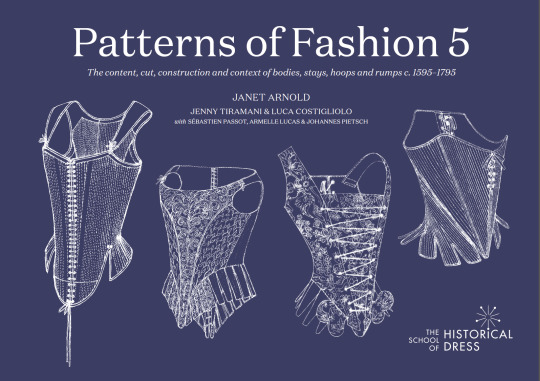
Patterns of Fashion 5: the content, cut, construction & contexto of bodies, stays, hoops & rumps, c 1595-1795, by Janet Arnold, Jenny Tiramani, Luca Costigliolo, Sebastien Passot, Armelle Lucas and Johannes Pietsch, The School of Historical Dress, 2019
The new book from the series is about undergarments from the 16th to the 18th century. It is only available through the store of the School of Historical Dress. Probably the best spent £35.
Themes: fashion, undergarments, stays, womenswear, England, extant garments, museums, Europe, patternmaking, 16th century, 17th century, 18th century.
Available at: The School of Historical Dress

Pictorial Encyclopedia of Historic Costume: 1200 Full-Color Figures, Karl Rohrbach (Author), Albert Kretschmer (Compiler), Dover Fashion and Costumes, 2007, ISBN-10: 0486461424
A reprint of Die Trachten Der Völker from 1906, this book, this is a great great encyclopedic work of fashion history, from ancient Egypt to late 19th century. It includes clothes for people of different social backgrounds, accessories, jewels, shoes, etc. I think that for the fashion history lover, the Rohrbach+Racinet combo is a must.
Themes: fashion, interior design, furniture, 18th century, 19th century, fashion history, ancient times, middle ages, renaissance, baroque, rococo, victorian, menswear, womenswear.
Available at: Amazon / Dover Publications
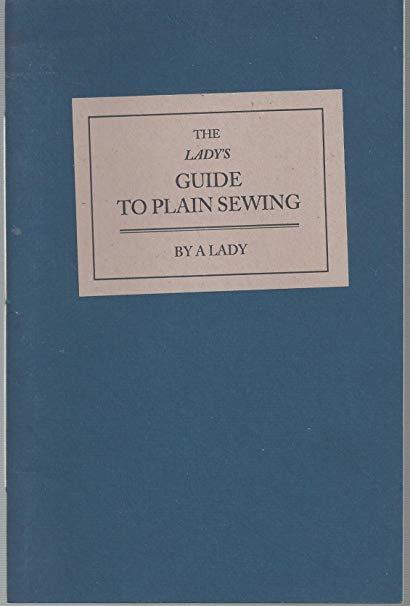
The Lady's Guide to Plain Sewing, Book I, Kathleen Kannik, ISBN 10: 0-9640161-0-9
References and tips for plain hand sewing, a key reference to achieve basic stitches that are historically accurate. It includes basic construction of items and some decorative techniques. Many of these techniques are still used in couture. This book is part 1 of a set of 4.
Themes: fashion, undergarments, womenswear, menswear, sewing, stitches, techniques, how to, patternmaking, 17th century, 18th century, 19th century, 20th century, couture.
Available at: Kannik’s Korner / Amazon (kindle edition) / Amazon

The Lady's Guide to Plain Sewing, Book II, Kathleen Kannik, ISBN 0-9640161-2-5
More sewing stuff with additional stitches and seam techniques, gather attachments, button making, gussets, re-enforcements, cord making, and an 18th century alphabet for cross stitching. This book is part 2 of a set of 4.
Themes: fashion, undergarments, womenswear, menswear, sewing, stitches, techniques, how to, patternmaking, 17th century, 18th century, 19th century, couture.
Available at: Kannik’s Korner / Amazon
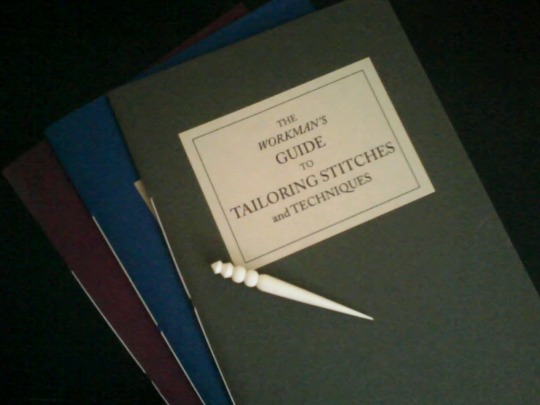
The Workman's Guide to Tailoring Stitches and Techniques, Kathleen Kannik, ISBN 0-9640161-4-1
Now it’s time for historical tailoring stitches and techniques. This book is part 3 of a set of 4.
Themes: fashion, tailoring, menswear, sewing, stitches, techniques, how to, patternmaking, 17th century, 18th century, 19th century.
Available at: Kannik’s Korner / Amazon

The Lady's Economical Assistant or, The Art of Cutting Out, and Making, The most useful Articles of Wearing Apparel, Without waste; Explained by the Clearest directions, and Numerous Engravings, of Appropriate and Tasteful Patterns, ISBN 0-9640161-3-3
A re-drawn publication of a 1808 book, with cutting directions and patterns for infant clothes, girls, boys, some for men and women, and linens. Many illustrations and a supplement. This book is part 4 of a set of 4.
Themes: fashion, undergarments, kidswear, children, babies, infants, womenswear, menswear, sewing, stitches, techniques, how to, patternmaking, 17th century, 18th century, 19th century.
Available at: Kannik’s Korner / Amazon

The American Duchess Guide to 18th Century Dressmaking: How to Hand Sew Georgian Gowns and Wear Them With Style, by Lauren Stowell and Abby Cox, Page Street Publishing, 2017, ISBN-10: 1624144535
This book is such a good starting point for a 18th century wardrobe, since it walks you through the key outfits of the century in a simple and clear way. I think a background in patternmaking is a plus, especially for the most complex projects, but the basics are easy to follow.
Themes: fashion, patternmaking, how to, womenswear, 18th century.
Available at: Amazon / American Duchess
BEAUTY

18th Century Hair & Wig Styling: History & Step-by-Step Techniques, Kendra Van Cleave, Nice One, ISBN-10: 0692220437
Kendra van Cleave have been everyone’s guide into the 18th century beauty and hair (and of course, costuming) for quite a long time, thanks to her blog, Démodé, and now she published this well researched book with easy to follow instructions for all kinds of 18th century hairstyles. So, go get your wig and get to work. Also, at the book’s website there some videos, and at her blog you can find even more resources, tutorials, etc.
Themes: fashion, beauty, hair, wigs, 18th century, how to.
Available at: Amazon / 18th Century Hair Website

The American Duchess Guide to 18th Century Beauty: 40 Projects for Period-Accurate Hairstyles, Makeup and Accessories, by Lauren Stowell and Abby Cox, Page Street Publishing, 2019, ISBN-10: 1624147860
I KNOW this is not available yet, but I think it will be at least as good as the fashion one. Already on my pre-order list, it will be available on July 9th.
Themes: hair, hairstyles, hair and makeup, makeup, accessories, how to, womenswear, 18th century.
Available at: Amazon / American Duchess
#sometimes I write stuff#books#my 18th century library#or something#18th century#fashion#history#beauty
623 notes
·
View notes
Text
These Doll Descriptors Mean Nothing
I just saw an antique mechanical doll depicting a baby in a cradle listed as a “mourning doll" on eBay...when the mechanical elements make it move
right
this MOVING BABY is supposed to be dead. sounds legit
so let’s get into some outdated/meaningless antique doll terms, shall we?
1. Mourning doll. This old chestnut is so popular that even the great Caitlin Doughty of Ask A Mortician repeated it on her blog. Those death-obsessed Victorians just loved making wax models of their deceased children, dressed in the child’s clothes (or garments made from the fabric thereof) and wigged with the child’s hair. How spooky! How conveniently perfect for modern horror stories! How-
-fake.
I’ve heard exactly ONE confirmed story of a doll modeled after a dead child, and that was a single doll made by a family of dollmakers and never sold.

(wax doll c. 1900, allegedly modeled on Patrick Enrico Pierotti, a child of the famous Pierotti dollmaking family who died in infancy. V&A Museum)
You often see these labeled as “mourning dolls”:

(wax doll depicting a baby lying on its back, amongst flowers. probably 19th century. private sale.)
Hate to disappoint, but they were usually devotional pieces meant to represent the infant Christ. womp womp.
I’ve also seen no convincing evidence of alleged “death kits-” toy funeral kits sold to little Victorian girls so they could learn to care for the dead. Staging a doll’s funeral did happen, based on extant photographs, but kids play at every stage of life with their dolls even now. And most of those photos involve setups any child could create with things around the house, as well as perfectly ordinary dolls.
2. Frozen Charlotte. Another popular example of Those Spooky Macabre Victorians is the rumor that little one-piece ceramic dolls common in the era were named for the 1840s poem “Fair Charlotte,” about a young lady who freezes to death on the way to a winter ball.

(There are larger examples of one-piece ceramic dolls from this era, but most are small and rather crudely painted; see above)
However, that term seems to have originated among collectors in the 1940s. Contemporary sources simply call the dolls “penny dolls” or “penny babies,” in reference to their low prices.
3. Mignonettes. Little jointed all-bisque dolls have been commonly given this name among collectors for ages. However, there’s no evidence for its contemporary use- the French seem to have called them “poupees a poche,” (pocket dolls), and most of them came from Germany anyway.

(All-bisque doll by the Kestner firm, late 19th century)
4. Milliner’s models. Another bit of collecting jargon often used for dolls of the early to mid-19th century with papier-mache heads. Invented in the 20th century to reflect the fanciful and entirely unsupported notion that thy were used to model the latest fashions in shops, as opposed to being primarily toys with secondary, coincidental fashion-related functions for a child’s mother, older sister, etc. Contemporarily, they seem to have been called “varnished-head dolls” when referenced as a distinct category at all.
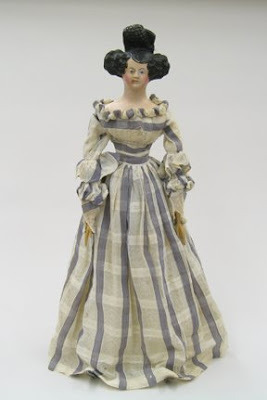
(Papier-mache headed doll c. 1830s)
There are many more, but there are four of the most common to look out for!
339 notes
·
View notes